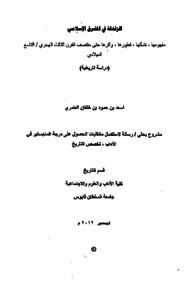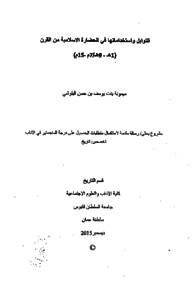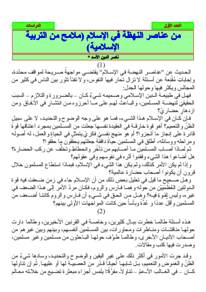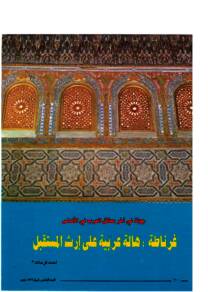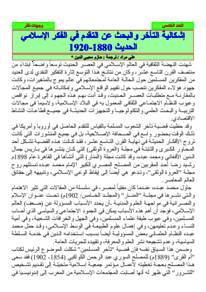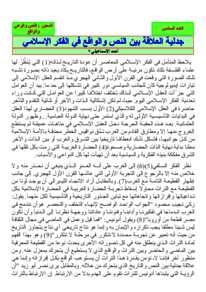Document
الزندقة في المشرق الإسلامي : مفهومها، نشاتها، تطوّرها، وأثرها حتى منتصف القرن الثالث الهجري/ التاسع الميلادي : دراسة تاريخيّة.
Publisher
جامعة السلطان قابوس
Gregorian
2012
Language
Arabic
English abstract
The study aimed to clarify the concept of Heresy, and how it was established and progressed, and the attitude of Arabs before Islam towards it, and it illustrated its relations with some religions, beliefs and other movements. It also indicated the attitude of the authority and the community towards it. It also showed the reasons of fighting it, the ways of utilizing it and its effects. The study coverd the movement of Heresy in the Islamic East from its begioning in the third century AD until the mid-third century AH / ninth century. The study used descriptive and analytical approaches; to describe and analyze the events and facts contained in the study. The study was divided into a preface and three chapters. The preface coverd the linguistic and the terminological meaning of the concept Heresy, the beginning of it, the attitude of the Sasanian empire from it, the reasons of fighting it. It also discussed the validity of the saying of some Arabs converting to it. The first chapter covers the Heresy in the Umayyad period. It talked about the relation of Arabs with non Arab muslims, and the relation of the Heresy with the Populism and with other religions and beliefs. It also talked about how it was broken up and how its concept became clear. It included some examples of the real heretics and the accused. The second chapter was titled Atheism in the Abbasid era, where the study highlighted more on the differences that occurred among the heretics, and the development that has occurred in its teachings, and the relationship of the Persians with it, and some profiles of their books, and the role of Christians in spreading heresy. It also highlighted the ways of fighting the heresy by the Abbasid caliphs and the society. It included some examples of utilizing it and some examples of the real heretics and the accused. The third and the final chapter coverd the religious, scientific, literary, social, and political effects of heresy. The study found a number of results; including: the real keresy is the Manichean, and the teachings of Manichaeism are the cause of fighting it, and the impossibility of heretic Arabs for political, economic, social, and geographical reasons. The study also showed a relationship of some of the Persians and some of the followers of some religions and faiths (especially Christians) in the dissemination of heresy, and why. The study detailed the aspect of the evolution of some of its teachings, and the reasons of its breaking up, as well as the new causes of the Abbasids caliphs fighting against it, and the likelihood of the innocence of the accused heretic of heresy. The study also found the diversity of the effects of heresy; to include all aspects of life in the Abbasid era, and that some of these effects is still heralded to this day; of discord among Islamic sects; as a result of the false Ahadith (the sayings of the Prophet Mohammed PBUH(, Therefore, the study recommends to reconsider the validity of some of the Ahadith, even if the narrators are trustworthy comparing them with the Holy Koran, and the biography of our Prophet - peace be upon him - The study recommends to re-read some of the periods and the events of the Islamic history, in terms of their causes; especially after we knew the Alliance of heresy and populism against Islam and Arabism. Thus, some historical novels in our sources have been mutilated.
Description
رسالة جامعية
Member of
Resource URL
Arabic abstract
هدفت الدراسة إلى توضيح مفهوم الزندقة ، وكيفية نشأتها ، وتطورها ، وموقف العرب في الجاهلية منها ، وتوضيح علاقتها ببعض الأديان والعقائد والحركات الأخرى ، وتبيان موقف السلطة والمجتمع منها ، وأسباب محاربتها ، وطرق استغلالها ، وأهم آثارها. وقد غطت الدراسة المشرق الإسلامي فيما يتعلق بحركة الزندقة ؛ منذ نشاتها بالقرن الثالث الميلادي ، حتى منتصف القرن الثالث الهجري / التاسع الميلادي . واستخدمت المنهجين الوصفي والتحليلي في التعامل مع الأحداث والوقائع الواردة في الدراسة. تم تقسيم الدراسة إلى تمهيد وثلاثة فصول ، تناول التمهيد المعنى اللغوي والاصطلاحي لمفهوم الزندقة ، ونشأتها، وموقف الدولة الساسانية منها ، وأسباب محاربتها ، ومناقشة صحة مقولة اعتناق بعض العرب لها ( الحيرة وقريش). وتناول الفصل الأول الزندقة في العصر الأموي ، حيث تم التطرق إلى علاقة العرب بالموالي في المجتمع الإسلامي ، وعلاقة الزندقة بالشعوبية وبعض الأديان والعقائد الأخرى ، وانقسامها ، إضافة إلى اتضاح مفهومها ، مع نماذج على الزنادقة الحقيقيين ، والمتهمين . أما الفصل الثاني فكان بعنوان الزندقة في العصر العباسي ، حيث ألقت الدراسة الضوء بصورة أكبر على الاختلاف الذي وقع بين صفوف الزنادقة ، والتطور الذي حدث في تعاليمها ، وعلاقة الفرس بها ، ونبذة عن كتبهم ، ودور النصارى في نشر الزندقة ، وطرق محاربة الخلفاء العباسيين والمجتمع لها، ونماذج على استغلالها ، وأخرى على الزنادقة الحقيقيين والمتهمين بالزندقة . أما الفصل الثالث والأخير فقد تناول آثار الزندقة : الدينية، والعلمية ، والأدبية ، والاجتماعية ، والسياسية. وقد توصلت الدراسة إلى عدد من النتائج ؛ منها : أن الزندقة الحقيقية هي المانوية ، وتعاليم المانوية هي السبب في محاربتها ، واستحالة تزندق العرب لأسباب سياسية ، واقتصادية ، واجتماعية ، وجغرافية . كما أوضحت الدراسة علاقة فئة من الفرس وبعض أتباع الأديان والعقائد (خاصة النصارى) في نشر الزندقة ، وأسباب ذلك ، كما فصلت الدراسة الجانب المتعلق بتطور بعض تعاليمها ، وأسباب انقسامها ، إضافة إلى الأسباب الجديدة لمحاربة خلفاء بني العباس لها ، وترجيح براءة وتزندق بعض المتهمين بالزندقة . كما توصلت الدراسة إلى تنوع آثار الزندقة ؛ لتشمل كافة جوانب الحياة في العصر العباسي ، وان بعض تلك الآثار ما زالت شاخصة حتى اليوم : وتتمثل في الفرقة بين المذاهبية الإسلامية : نتيجة الأحاديث الموضوعة.
وعليه توصي الدراسة بإعادة النظر في صحة بعض الأحاديث ، وإن كان السند صحيحا بمقارنتها مع القران الكريم ، وسيرة نبينا - صلى الله عليه وسلم - . كما توصي الدراسة بإعادة قراءة بعض فترات وأحداث التاريخ الإسلامي ، من حيث مسبباتها ؛ خصوصا بعدما عرفنا تحالف الزندقة والشعوبية ضد الإسلام والعروبة ، وعليه أيضا فإن بعض الروايات في مصادرنا التاريخية هي الأخرى قد تعرضت للدس والتشويه.
وعليه توصي الدراسة بإعادة النظر في صحة بعض الأحاديث ، وإن كان السند صحيحا بمقارنتها مع القران الكريم ، وسيرة نبينا - صلى الله عليه وسلم - . كما توصي الدراسة بإعادة قراءة بعض فترات وأحداث التاريخ الإسلامي ، من حيث مسبباتها ؛ خصوصا بعدما عرفنا تحالف الزندقة والشعوبية ضد الإسلام والعروبة ، وعليه أيضا فإن بعض الروايات في مصادرنا التاريخية هي الأخرى قد تعرضت للدس والتشويه.
Category
Theses and Dissertations

